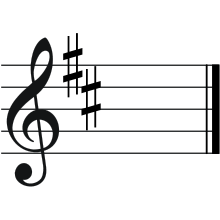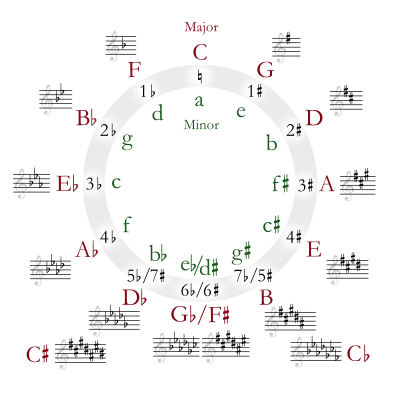B minor
 | |
| Relative key | D major |
|---|---|
| Parallel key | B major |
| Dominant key | F♯ minor |
| Subdominant | E minor |
| Component pitches | |
| B, C♯, D, E, F♯, G, A, B | |
B minor is a minor scale consisting of the pitches B, C♯, D, E, F♯, G, and A. Its key signature consists of two sharps. The harmonic minor raises the note A to A♯. Changes needed for the melodic and harmonic versions of the scale are written with accidentals as necessary.
Its relative major is D major, and its parallel major is B major.
Christian Friedrich Daniel Schubart (1739–1791) regarded B minor as a key expressing a quiet acceptance of fate and very gentle complaint, something commentators find to be in line with Bach's use of the key in his St John Passion.[1] By the end of the Baroque era, however, conventional academic views of B minor had shifted: Composer-theorist Francesco Galeazzi (1758–1819)[2] opined that B minor was not suitable for music in good taste. Beethoven labelled a B minor melodic idea in one of his sketchbooks as a "black key".[3] Brahms, Dvořák, Schubert, Liszt, Chopin, Borodin, and Tchaikovsky all wrote significant works in B minor.
Notable compositions in B minor
- J. S. Bach – Mass in B minor
- J. S. Bach - Orchestral Suite No. 2 in B Minor, BWV 1067
- J. S. Bach – French Suite No. 3 in B minor, BWV 814
- Bartók – Violin Concerto No. 2
- Berg - Piano Sonata, Op. 1
- Brahms – Clarinet Quintet
- Borodin – Symphony No.2
- Bottesini – Double Bass Concerto, No. 2 in B minor
- Chopin – Scherzo No. 1, Op. 20
- Chopin – Étude in B minor, Op. 25, No. 10
- Chopin – Piano Sonata No. 3, Op. 58
- Chopin – Waltz in B minor, Op. 69, No. 2
- Dvořák – Cello Concerto in B minor
- Grieg – In the Hall of the Mountain King
- Hummel – Piano Concerto No. 3, Op. 89
- Liszt – Piano Sonata in B minor
- Felix Mendelssohn – The Hebrides (Fingal's Cave) Overture
- Mozart – Adagio from Flute Quartet No. 1, K. 285
- Mozart – Adagio in B minor, K. 540
- Paganini – Violin Concerto No. 2 (La Campanella)
- Puccini – "E lucevan le stelle" from Tosca
- Saint-Saëns – Violin Concerto No. 3
- Schubert – Symphony No. 8 (Unfinished), D. 759
- Alexander Scriabin – Fantaisie in B minor, Op. 28
- Tchaikovsky – Symphony No. 6 (Pathetique), Op. 74
- Vivaldi – Concerto for 4 Violins and Cello, RV 580 (Concerto No. 10 from L'estro Armonico)
- Wagner – Ride of the Valkyries from Die Walküre
References
Notes
Sources
- Galeazzi, Francesco. Elementi teorico-pratici di musica con un saggio sopra l'arte di suonare il violino analizzata, ed a dimostrabili principi ridotta. Ascoli: 1817. See also Francesco Galeazzi, The Theoretical-Practical Elements of Music, Parts III and IV; English translation, with introduction and commentary, by Deborah Burton and Gregory W. Harwood (Champaign, Illinois: University of Illinois Press, 2012); ISBN 978-0-252-03708-5.
- Tusa, Michael C. (1993). "Beethoven's 'C-Minor Mood': Some Thoughts on the Structural Implications of Key Choice". In Christoph Reynolds. Beethoven Forum. 2. Lincoln: University of Nebraska Press. ISBN 978-0803239098.
See also
External links
 Media related to B minor at Wikimedia Commons
Media related to B minor at Wikimedia Commons
| Diatonic scales and keys | |||||||||||||||||||||||||||||||||||||||||||||||||||||||
|---|---|---|---|---|---|---|---|---|---|---|---|---|---|---|---|---|---|---|---|---|---|---|---|---|---|---|---|---|---|---|---|---|---|---|---|---|---|---|---|---|---|---|---|---|---|---|---|---|---|---|---|---|---|---|---|
 |
| ||||||||||||||||||||||||||||||||||||||||||||||||||||||
| The table indicates the number of sharps or flats in each scale. Minor scales are written in lower case. | |||||||||||||||||||||||||||||||||||||||||||||||||||||||